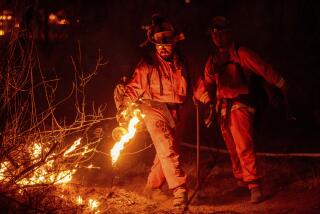Injuries Grow Among Nursing Home Workers : Workplace: The industry says statistics in union’s report are skewed. Still, the numbers are alarming.
- Share via
Mention hazardous jobs, and most people think about police work. Firefighting. High-rise construction. Or Hollywood stunt jobs.
But not nursing home work.
Then came a report, released earlier this year by the Service Employees International Union, titled “Caring Till It Hurts: How Nursing Home Work Is Becoming the Most Dangerous Job in America.”
In it, the Washington-based union representing 475,000 health care workers--including about 75,000 nursing home workers--contends that the job-related injury rate among nursing home employees is soaring, with nearly one in five workers injured annually.
The report has prompted protests from nursing home industry officials, who contend that the statistics have been skewed in the union’s favor and that efforts to resolve the injury problem are ongoing.
But on one point both sides agree: Reducing injuries is vital, especially because nursing home work is a fast-growing occupation. Currently there are 1.5 million workers in the nation’s 16,608 nursing homes, according to industry estimates. By
the year 2005, the nursing home industry is expected to add 750,000 new jobs, says a spokesman for the Division of Occupational Outlook at the U.S. Department of Labor’s Bureau of Labor Statistics.
More than 200,000 nursing home workers are injured each year, says Jamie Cohen, a spokeswoman for the union. Over the past decade, she adds, injury rates among nursing home workers have risen 55%. Lost workdays per 100 full-time nursing home workers have jumped from 98.2 in 1983 to 186.9 in 1993.
“Most [of the injuries] are due to back injuries from lifting and turning residents,” Cohen says. Back injuries account for 25% of all injuries reported in the private sector, but they account for 43% of injuries in nursing homes, she says, citing a 1990 Bureau of Labor Statistics report.
Nursing home workers are also prone to carpal tunnel syndrome, other upper extremity injuries, lower extremity problems, shoulder problems and injuries to the head and neck, the report says.
Particularly at risk, the union found, are nurse’s aides, who make up about 42% of the nursing home work force. Time lost from work can be especially devastating financially, the union argues, since the average nursing home worker earns just over $17,000 a year.
About 17% of nurse’s aides injured are off the job for 31 days or more, says union spokesman Peter Nixon, citing government statistics. Some injured workers are part-timers and thus ineligible for sick pay, he adds, and some nursing homes do not have generous sick leave policies even for full-time help.
Among recommendations made by the union are to hire more employees to reduce worker-resident ratios and to establish ergonomic standards.
The union also calls for safer lifting equipment, educational training programs on injury prevention and early treatment for injuries.
The nursing home industry objects to some of the union report’s findings. The union “took data and manipulated it,” says David Kyllo, a spokesman for the American Health Care Assn., a Washington-based trade group representing more than 11,000 nursing homes. For instance, he says, the report lumps all back injuries, major and minor, together.
When contacted, a union spokesman could not supply a breakdown of back injuries. Data for the report was derived from the Bureau of Labor Statistics, but “they don’t break it down into major and minor [back injuries],” Cohen said.
“We recognize there is a problem,” Kyllo says. “The number of injuries [in nursing homes] is higher than average.”
Still, he says, there is no one-size-fits-all solution. “If we take two like ergonomic programs and implement them in two different facilities, we don’t get the same results. There is no quick fix.”
Nursing homes are working to rectify the injury rate, Kyllo says, noting that one chain now teaches its employees stretching techniques to minimize injuries and that one facility has hired a consultant to develop an ergonomics standard.
In California, the picture is brighter than elsewhere, contends Kathy Byrne, spokeswoman for the California Assn. of Health Facilities, which represents more than 1,350 nursing homes, residential care homes and other facilities.
“All certified nursing assistants [also called nurse’s aides] are required to learn lifting techniques as part of their curriculum,” she says. “Our California CNAs receive 150 total training hours, compared to 75 nationally.”
The union objects to certain measures currently used by some nursing home administrators, such as “safety bingo.” This program rewards workers with prizes such as television sets and cash if no injuries are reported in a specified time period. Cohen calls this a gimmick and says it backfires by discouraging people who hope to win prizes from reporting their injuries.
Arun Garg, a professor of industrial and manufacturing engineering at the University of Wisconsin--Milwaukee, is convinced that reduction of injury rates is possible. In an ongoing study started in June, 1994, he has followed 300 employees of three Midwestern nursing homes after training them to use special safety equipment. “We found injuries decreased 80%,” he says. “Back injuries decreased 90%. Lost or restricted workdays declined 95%.”
Among the devices Garg calls especially valuable are plastic sheets with lubricants inside, which are temporarily slipped under a patient to ease repositioning in bed. He also recommends “walking belts,” specially designed canvas belts about four inches wide that have handles on the sides. A worker places the belt around a resident’s waist and pulls rather than lifts the patient to a standing position.
But even the best equipment can’t reduce injury rates if personnel are not properly trained, he says.
“An ongoing training program is vital,” Garg says.
More to Read
Inside the business of entertainment
The Wide Shot brings you news, analysis and insights on everything from streaming wars to production — and what it all means for the future.
You may occasionally receive promotional content from the Los Angeles Times.










